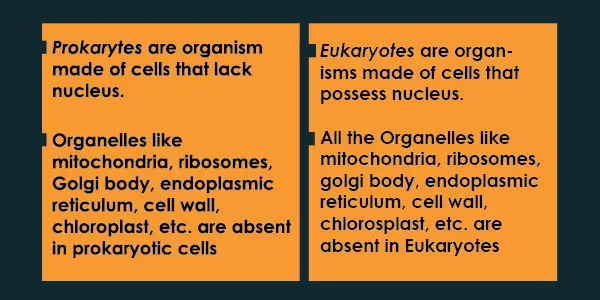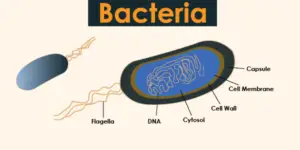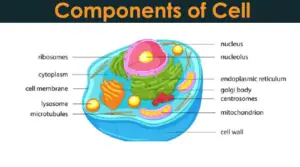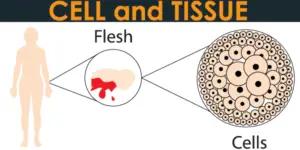
Difference between Prokaryotes and Eukaryotes
The very basic difference between prokaryotes and eukaryotes is that the prokaryotes do not have structures with membranes inside, that is, its intracellular content is scattered in the cytoplasm while the eukaryotes have a membrane that encloses the nucleus separating it from the cytoplasm.

The cell is the smallest unit of life, and it is a fundamental component to define ourselves as living beings. It is likewise viewed as a functional unit since it completes all the vital functions. The cell is the genetic unit, which contains the hereditary material and all come from another pre-existing cell.
Cells can be divided into two categories:
- Prokaryotes: such as bacteria;
- Eukaryotes: like human cells;
Differences between Prokaryotes and Eukaryotes side-by-side.
| Prokaryotes | Eukaryotes | |
| 1. | DNA located in one region: Nucleoid, not surrounded by membrane. | Nucleus surrounded by membrane. Fragmented genetic material on chromosomes made of DNA and proteins. |
| 2. | Small cells between 1 and 10 microns. | Usually large cells between 10 and 100 microns, some are microbes, most are large organisms. |
| 3. | It can be spherical, cane, comma orthographic, or spiral | They are unicellular or multicellular organisms. |
| 4. | Direct cell division, mainly by binary fission. There is no mitotic spindle or microtubules | Cell division by mitosis and meiosis, has mitotic spindle, or some of microtubules arrangement. |
| 5. | Located in nucleoid, without being surrounded by a membrane. | DNA and proteins form the chromatin that is concentrated in the nucleus. |
| 6. | Ribosomes are present but small (70S) | Ribosomes are present and large (80S) |
| 7. | Single cellular chromosomes. | Multiple chromosomes. |
| 8. | Expressed in groups called operons. | Expressed individually, they possess introns and exons. |
| 9. | Simple, formed by the flagellin protein. | Compounds, consisting of tubulin and other proteins. |
| 10. | Cellular walls are present. | Only present in plants and fungi. |
| 11. | Domains are Bacteria Archaea. | The Eukarya domain that groups plants, animal and fungi. |
| 12. | Examples: Staphylococcus aureus bacteria, archaea Halobacterium Salinarum. | Examples: Bread yeast Saccharomyces cerevisiae, the fruit fly Drosophila melanogaster, banana or banana Musa sp. |
Also Read: Difference between Plasma ad Serum
What are Prokaryotes?
What are prokaryotes? The prokaryotes are a simple organism composed of membrane and cytoplasm. They lack a nucleus and do not have organelles like eukaryotic cells have (eg. mitochondria, chloroplasts, and endoplasmic reticulum). Also, it has a cell wall that supports the cell.
Bacteria is the best example of prokaryotes as it is a single-celled organism. Just look at the picture below, You will notice that the bacteria do not have a nucleus to hold its DNA and the DNA is freely wandering inside the cytosol of the bacteria.

What are Eukaryotes?
What are eukaryotes? The eukaryotes are the building block of life for protozoans, fungi, plants, and animals. It is characterized by keeping its genetic material packed inside a membrane, forming the nucleus. It also has other intracellular structures surrounded by membranes, known as organelles.
Notice the picture below, it is a eukaryotic organism’s cell:
Humans are multicellular organisms made of trillions of cells together or we can say that humans are eukaryotes because they are made of multiple cells as the picture below is illustrating.

Similarities between Prokaryotes and Eukaryotes
While they are different there are also Similarities between Prokaryotes and Eukaryotes. Both contain genetic material, that is, DNA. They have a cell layer that covers them. Since both are made up of carbohydrates, proteins, nucleic acid, minerals, fats, and vitamins.
Both prokaryotes and eukaryotes cells contain ribosomes, which make proteins. They also reproduce, although in different ways. They need energy to survive, they contain cytoplasm inside cells and a cytoskeleton. The two classes of cells have a lipid bilayer, known as the plasma layer.
Conclusion (Difference between Prokaryotes and Eukaryotes)
After going through the above words we can conclude that both prokaryotes and eukaryotes are organism categories playing their part in nature but distinct at the cellular level. According to scientists eukaryotes came after prokaryotes, and prokaryotes exist million years ago.
You may also enjoy reading: